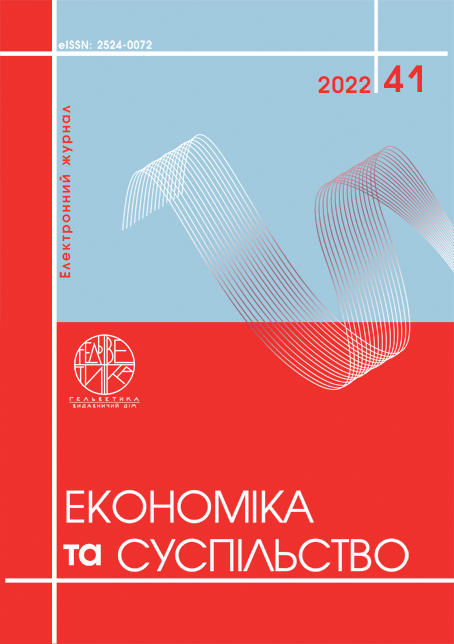CONDUCTION OF NEUROMARKETING RESEARCH TO INCREASE THE EFFICIENCY OF ADVERTISING ACTIVITIES
Abstract
More and more famous global brands use neuromarketing research, which includes instrumental and socio-psychological methods. Marketers use positive impulses and stimuli in the form of smells, music, colors, lighting, product display, price manipulation, etc. to construct the emotions of buyers and influence subconscious perception. The article discusses neuromarketing research as a means of increasing the effectiveness of advertising. Research in the field of human neuropsychology is extremely important for predicting consumers’ behavior, which is a decisive factor in marketing activities. In general, the need for marketing research is determined by the need to obtain information to minimize or eliminate marketing risks when making decisions, which is ensured by the availability of reliable data. The ability to study, research and analyze consumers’ behavior provides great opportunities for the effective work of marketing specialists. Traditional marketing research, despite the availability of research methods that have become classical long ago, does not always allow obtaining reliable information, due to errors that arise in the process of working with respondents. Instead, neuromarketing research is designed to provide a deeper analysis of the brain activity response of potential or actual consumers. Since with the development of informatization and digitalization, the consumer becomes more demanding, there is a need to expand the use of marketing and neuromarketing research tools. Therefore, the combination of psychological sciences, neurosciences and marketing can give fruitful results. Neuromarketing is certainly an innovative and promising promotion tool. However, the possibilities of its use in the work of a particular company must be carefully considered in advance. The use of neuromarketing methods requires significant funds, which representatives of small and medium-sized businesses cannot afford. Neuromarketing today is one of the marketing technologies of the future, and therefore needs further study.
References
Вудвуд В.В., Білоус А.Я. Нейромаркетинг – новітній інструмент впливу на поведінку споживачів у недосконалих умовах ринкової економіки України. URL: http://innoveconom.in.ua/archive/InnEco_7-45/50.pdf
Жмай О.В. Становлення та розвиток концепції нейромаркетингу в сучасних умовах. Ринкова економіка: сучасна теорія і практика управління. 2018. Т. 17. Вип. 1(38). С. 157–170. DOI: https://doi.org/10.18524/2413-9998.2018.1(38).135569
Belasku A. (2020). Neuromarketing ethics: how far is too far? URL: https://cxl.com/blog/neuromarketing-ethics
Dengfeng Yan, Jaideep Sengupta (2021). The Effects of Numerical Divisibility on Loneliness Perceptions and Consumer Preferences. Journal of Consumer Research. Vol. 47. Issue 5. February. P. 755–771. DOI: https://doi.org/10.1093/jcr/ucaa026
Hayes S.C., Law S., Malady M., Zhu Z. & Bai X. (2019). The centrality of sense of self in psychological flexibility processes: What the neurobiological and psychological correlates of psychedelics suggest. Journal of Contextual Behavioral Science. DOI: https://doi.org/10.1016/j.jcbs.2019.11.005
Jerath Kinshuk and Ren Qitian. (2020). Consumer Attention to Favorable and Unfavorable Product Information, and Firm Information Design (January 7, 2020). DOI: http://doi.org/10.2139/ssrn.3515285
Krajnovic A., Sikiric D., Jasic D. (2012). Neuromarketing and customers free will. Proceedings of the 13th Management International Conference. P. 1143–1163.
Lindstrom M. (2010). Buyology: Truth and Lies About Why We Buy. Currency. 272 p.
Murphy E.R., Illes J., Reiner P.B. (2008). Neuroethics of neuromarketing. Journal of Consumer Behaviour: An International Research Review, Vol. 7, issue 4‐5, pp. 293–302. DOI: https://doi.org/10.1002/cb.252
Meyer J.H., De Ruyter K., Grewal D. et al. (2020). Categorical versus dimensional thinking: improving anti-stigma campaigns by matching health message frames and implicit worldviews. J. of the Acad. Mark. Sci. 48, 222–245. DOI: https://doi.org/10.1007/s11747-019-00673-7
Woodwood V., Bilous A. (2018) Neuromarketing is the newest tool for influencing consumer behavior in imperfect conditions of the market economy of Ukraine. Available at: http://innoveconom.in.ua/archive/InnEco_7-45/50.pdf
Zhmay O. (2018) Formation and development of the concept of neuromarketing in modern conditions. Market economy: modern theory and practice of management. Vol. 17. Issue. 1(38). P. 157–170. DOI: https://doi.org/10.18524/2413-9998.2018.1(38).135569
Belasku A. (2020) Neuromarketing ethics: how far is too far? Available at: https://cxl.com/blog/neuromarketing-ethics
Dengfeng Yan, Jaideep Sengupta (2021) The Effects of Numerical Divisibility on Loneliness Perceptions and Consumer Preferences. Journal of Consumer Research. Vol. 47. Issue 5. February. P. 755–771. DOI: https://doi.org/10.1093/jcr/ucaa026
Hayes S., Law S., Malady M., Zhu Z. & Bai X. (2019) The centrality of sense of self in psychological flexibility processes: What the neurobiological and psychological correlates of psychedelics suggest. Journal of Contextual Behavioral Science. DOI: https://doi.org/10.1016/j.jcbs.2019.11.005
Jerath Kinshuk and Ren Qitian. (2020). Consumer Attention to Favorable and Unfavorable Product Information, and Firm Information Design (January 7). DOI: http://doi.org/10.2139/ssrn.3515285
Krajnovic A., Sikiric D., Jasic D. (2012) Neuromarketing and customers free will. Proceedings of the 13th Management International Conference. P. 1143–1163.
Lindstrom M. (2010) Buyology: Truth and Lies About Why We Buy. Currency. 272 p.
Murphy E., Illes J., Reiner P. (2008) Neuroethics of neuromarketing. Journal of Consumer Behaviour: An International Research Review, Vol. 7, issue 4–5, pp. 293–302. DOI: https://doi.org/10.1002/cb.252
Meyer J., De Ruyter K., Grewal D. et al. (2020) Categorical versus dimensional thinking: improving anti-stigma campaigns by matching health message frames and implicit worldviews. J. of the Acad. Mark. Sci. 48, 222–245. DOI: https://doi.org/10.1007/s11747-019-00673-7


